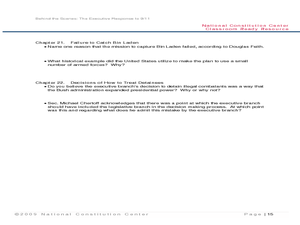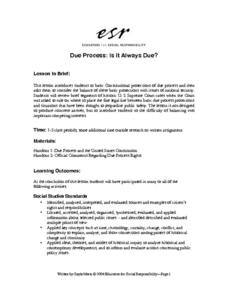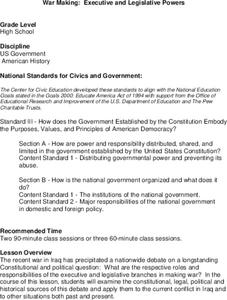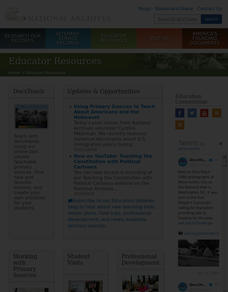Curated OER
Celebrate Hispanic Heritage Month!
Young scholars use information from the U.S. Bureau of the Census to create a bar graph, a picture graph, or a circle graph showing the country of origin of U.S. Hispanics.
Curated OER
How was the Constitution Used to Organize the New Government?
How did the United States Congress determine how the new president and vice president would be named when the nation was first established? Who would provide money for the government, and how would the executive branch be organized?
Curated OER
The Ongoing Debate: Crime Control v. Due Process Protection
Students investigate the Exclusionary Rule and other ways of to enforce the protections found in the Bill of Rights. They study how effective criminal control and public safety is carried out while citizens Constitutional rights are...
Curated OER
Launching Your Ship with Citizenship Lesson 4: Hoisting the Flag
Students discuss the U.S. electoral process and brainstorm solutions to increase voter turnout in their community. In this democratic citizenship instructional activity, students identify keywords in speech and video related to freedom...
Close Up Foundation
Rights Auction
In an engaging activity on universal and unalienable rights, learners work in groups to establish a democratic nation and determine what principles they want to protect to ensure a democratic society. They conduct a "rights auction" in...
National Endowment for the Humanities
The House Un-American Activities Committee
Was the House Un-American Activities Committee justified in investigating subversive influences in the entertainment industry? Part two of the three-part series of lessons that examine the anti-communism movement after World War II,...
Curated OER
The Constitution: The Country's Rules
Pupils become aware of the Constitution and why it is important. In this early government lesson, students compare the Constitution to the class rules. They are both set in place so that we all stay safe and have fun. Pupils draw...
Curated OER
Behind the Scenes: The Executive Response to 9/11
Students examine the actions of the executive branch following the September 11th terrorist attacks. In this U.S. government lesson, students watch segments of a video titled "Behind the Scenes: The Executive Response to 9/11." Students...
Curated OER
Due Process: Is It Always Due?
Students explore the basic Constitutional protections of due process and then consider the balance of these basic protections with issues of national security. A variety of segments of U.S. Supreme Court cases are examined in this lesson.
Curated OER
Supreme Court June 2010 Decisions Wrap-Up
High schoolers consider constitutional rights. In this Bill of Rights lesson, students complete an activity guide that requires high schoolers to examine Bill of Rights-related cases of 2010. Students respond to discussion questions...
Curated OER
War Making: Executive and Legislative Powers
Students examine Constitution and what it says about war-making power, contrast roles and responsibilities of executive and legislative branches of government when it comes to making war, become familiar with important 20th and 21st...
Curated OER
An Early Threat of Secession: The Missouri Compromise of 1820 and the Nullification Crisis
Students analyze an interactive map of the Missouri Compromise to identify the regions and their relation to slavery. In this pre-civil war era lesson, students read primary source documents and research online to answer questions...
Curated OER
Bill O'Rights
Learners discuss and identify the first ten amendments to the Constitution and apply their understanding of the material to how they currently affect their lives. They discover the rights and responsibilities of being a citizen, and...
Curated OER
Sow the Seeds of Victory!
Students use the National Archives and Records Administration's records to research the history of the U.S. Food Administation.
Curated OER
The President: Politician in Chieft
Students explore the role of the U.S. President and the media coverage in presidential elections. They discuss what it means to be informed, the issues they consider most important, and reflect on what they learned from their interviews....
Curated OER
Memorandum Regarding the Enlistment of Navajo Indians
Learners examine the Navajo dictionary used by the U.S. military in W.W. II. They role-play Navajo messengers and Marine Corp staff. They research the Battle of Iwo Jima and confirm or discount the claim that Navajos made the victory...
James Madison Memorial Fellowship Foundation
A Picture is Worth a Thousand Words
This exercise on the Constitution requires small groups to design a visual metaphor that expresses the concept behind one of seven principles: popular sovereignty, federalism, republicanism, separation of powers, checks and balances,...
American Bar Association
What Is Separation of Powers?
Who has the power? Scholars investigate the creation of the three branches of government in the United States Constitution. They analyze just why the framers created the branches the way they did.
Judicial Learning Center
Types of Court Cases
How can one court acquit someone of a crime, while another convicts the person of the same one? It's all because of the differences between civil and criminal trials. An informative resource provides scholars in the field of criminology...
Curated OER
The Role of the Executive Branch in the Lawmaking Process
Students research the Executive Branches role in making a law. In this law making lesson plan, students study the history of the Constitution and see how much power the President has in making a bill into a law. Students then research on...
Curated OER
Inspiration for and Application of the Bill of Rights
Learners examine individual rights. In this case law lesson plan, students discuss the from and function of the Bill of Rights prior to investigating several cases that deal with Constitutional rights. Learners discuss the outcome of the...
Curated OER
America 2000: Federal Round Table Discussion
Eighth graders examine the United States Constitution and identify the beliefs and values Americans follow today. In groups, they compare and contrast state's rights and federal rights and the issues affecting them. They debate the...
Curated OER
Civil War and Reconstruction
Fourth graders investigate the Civil War by researching the state of Virginia. In this US History instructional activity, 4th graders identify Abraham Lincoln, James Chestnut and Fort Sumter, and discuss their roles in the start of...
Curated OER
History Mystery Message Challenge
Eleventh graders examine the US Constitution. In this American Government lesson, 11th graders gather the history and government facts to solve the history message.

























